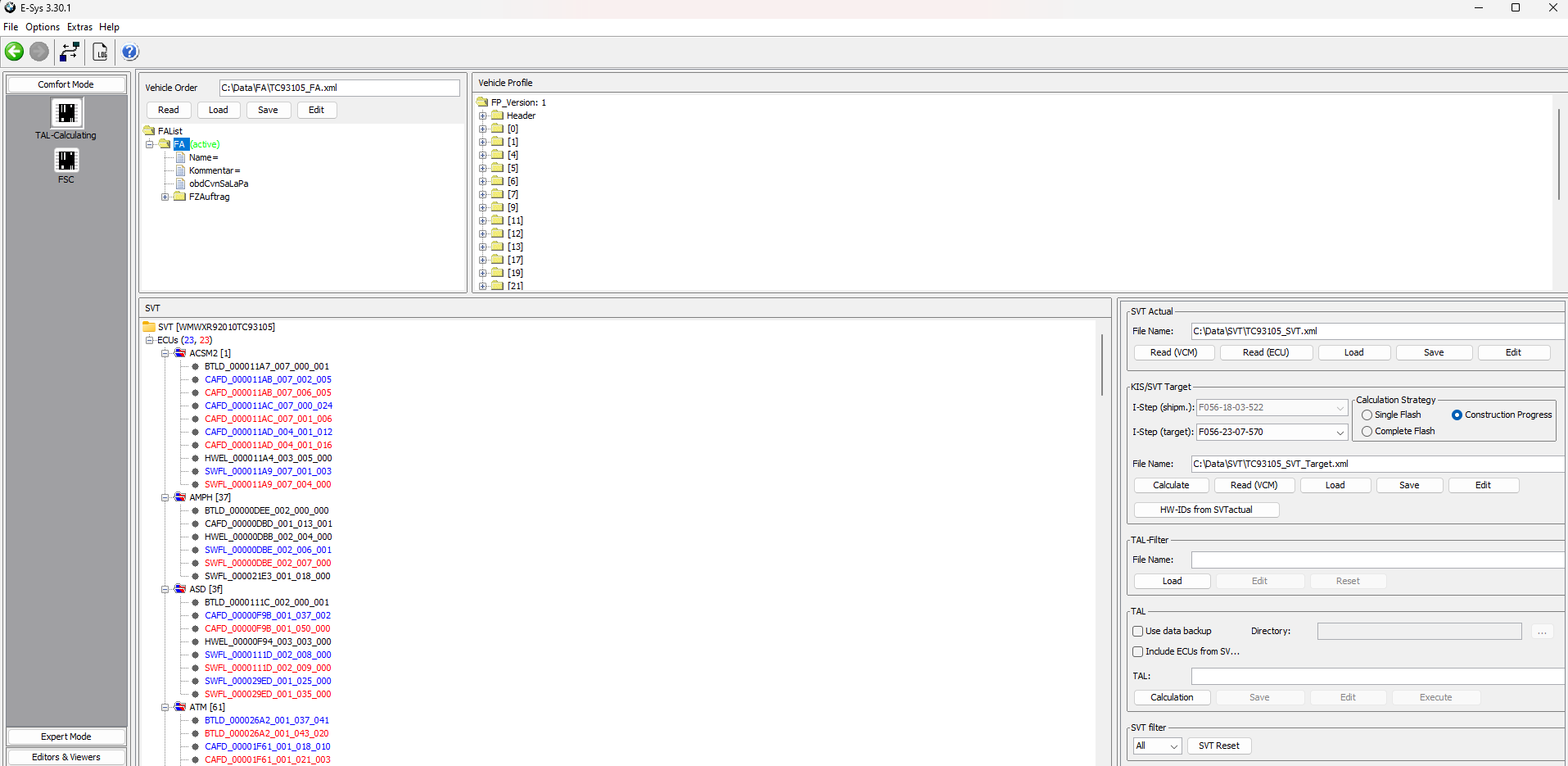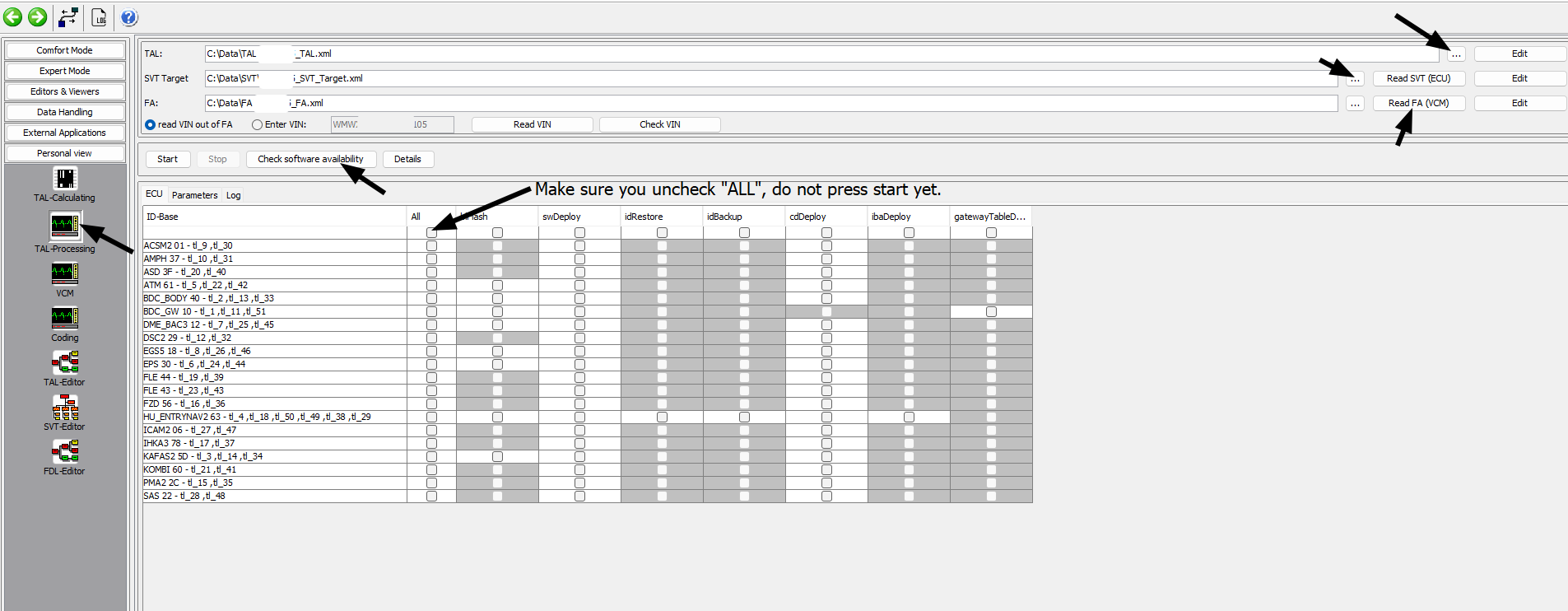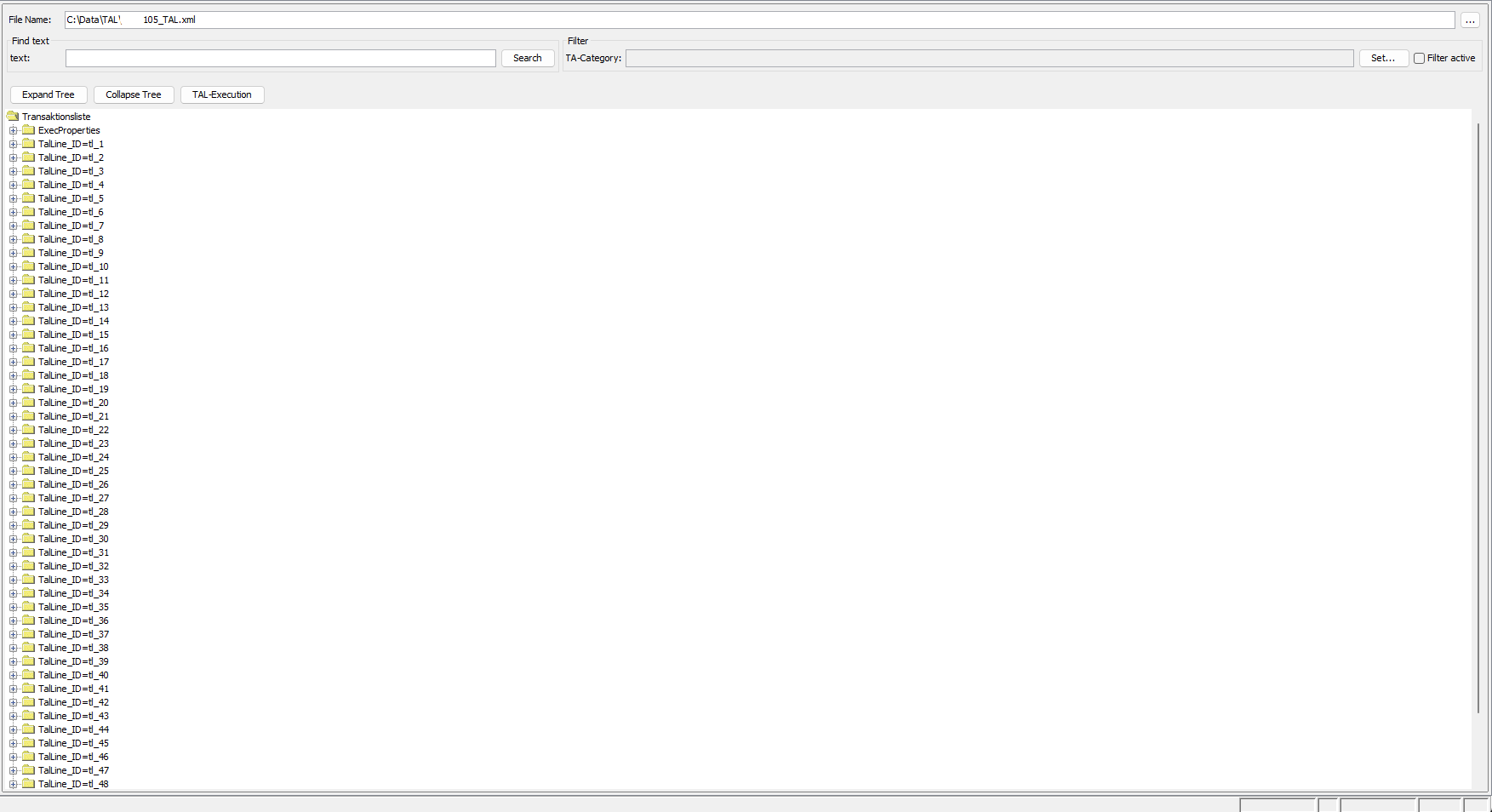Cabooshy's Musings
Bimmercode/E-Sys - Updating your ID5 Headunit (LCI1) to ID6_Light
Preface
This tutorial assumes you either know how to navigate E-Sys, and are willing to update the car to a recent I-Level, or have had the car updated at a dealer, I will show how to do it, but i do not take any responsibility for bricked ECU's.
THIS TUTORIAL IS AIMED AT LCI1 (First Facelift) F SERIES MINI'S and should work on all F chassis cars that do not have the "Radio Boost" (Radio only) or
"Visual Boost" Headunit (Display and Headunit are one piece, does not have Nav, also known as the BIS headunit)
Tutorial
Step 1, Checking your Headunit:
This is the "fun" part, Officially, the 6.5in display is no longer made, as from the LCI2 facelift, all MINI's got the 8.8in screen as standard, but for the LCI1 Facelift, the Radio options are as follows:
- Radio Boost: The super basic Radio-only headunit.
- (BIS) Visual Boost: This is the basic 6.5in non-touchscreen unit used for the super basic Mini Connected Setups, it can't be tinkered with, does not have Navigation available to it, at all, No Carplay, and due to having a different connector, is also a pain to retrofit a NBT/EVO system into, the Headunit and Display are all one piece.
- Mini Connected 6.5in w/ Navigation: the touchscreen 6.5in Headunit, the headunit and display are seperate, have way more customisability, have Carplay available to them, Navigation is also available to these headunits, if the car was specced with Carplay, you will have this headunit.
- Mini Connected XL 8.8in w/ Navigation: This is the same as the above headunit in terms of features and such, but with the 8.8in touchscreen display, everything available to the smaller screen is available here, this headunit will also have the best compatability with ID6_Light, as IDrive 6 proper on the LCI2 cars is 8.8in only.
So, if your MINI headunit has 6/7 options (Carplay shows as an option on the main menu when connected to a supported iPhone), similar to the below:

If your headunit has a layout close to either of these with 6/7 Options: Mini Connected, My Mini, Navigation, Carplay (if car was specced with Carplay and iPhone is connected), Notifications, Communication, Media/Radio, You will be able to do this.
Step 1A, Checking the Car's I-Level
What you're looking for in these are the I-Levels, depending on how you get the information it will be displayed differently, but the three values the car stores are:
- Current – This is the current I-Level the car is running.
- Last – This is the last I-Level the car was running before the most recent I-Level Update.
- Shipment – This is the I-Level that the car was running when it was built in the factory.
There's three ways you can do this check:
- Bimmercode – The Car icon in the title bar brings up all the VCM information and a decoded list of your SA Option Codes. it will show the Current, Last, and Shipment I-Levels the car has.
- ISTA+ – Once you have connected the car to ISTA and it has read out all of the information, the screen you are presented with will show your Shipment I-Level and Current I-Level.
E-Sys – Connect to the Car, Go to Expert Mode -> VCM, then in the Master Tab, in the I-Steps box, click read, it will fill out the Integration Steps box with the Car's Shipment, Last, and Current I-Level's, (this box is what Bimmercode reads out when you click into the Car icon)
If your Current I-Level is over 21-03, then you can skip Step 2 and proceed to Step 3, Bimmercode.
Step 2, Updating the Car's I-Level (WIP)
The information here is not final, i recommend not following this until the WIP is removed from the title
As a reminder, this only applies to the IDrive 5 headunits found in the LCI1 cars (Build Dates 03-2018 to 02-2021, US Model Years: 2019-2021)
E-Sys is….. terrifying if you've never used software of this caliber before, i highly reccomend watching through BimDoc's E-Sys for Dummies series on Youtube before attempting this, as i will not be explaining how to use the software outside of the scope of Updating the ECU's.
i will also not be providing links to any of the software and databases required for this job, google is your friend.
Prerequisites
- ISTA+ (also called ISTA-D/Rheingold) for diagnostics and clearing any fault codes, and if need be, initialising ECU's after an update.
- E-Sys (i reccomend either 3.34 or 3.36 for this as the general consensus is that these are the more stable versions of E-Sys, if they don't work/like the PSdZData you have, you are more than welcome to try a newer version)
- a recent PSdZData (you can get the latest one, as of writing this, i have 4.45.30 which contains F056_23_03_588 and F056_23_07_570.), the main thing here is that you want PSdZData_FULL, not PSdZData_LITE, the FULL database options contain all of the Software files required to update the ECU's, whereas the LITE databases have these stripped out and are only useful if you only plan on doing FDL/VO Coding with E-Sys.
- a Windows Laptop, Intel MacBooks with Bootcamp can work as well, but your mileage may vary and it might not be able to do Programming (I-Level updates and such)
- an ENET Cable, with USB Ethernet adapter if your laptop does not have a dedicated Ethernet jack.
- A Workshop PSU capable of supplying at least 70A to the car, or another car running as the PSU will work for small jobs.
ISTA Diagnosis
First things first, we want to Connect our PSU (or jump cables and start second car to act as PSU), open ISTA and connect to the car, and read out any fault codes the car has, if any at all, and then clear them. We do this because it gives us a clean sheet to easily find any fault codes that may come up from after we update the HeadUnit an BDC, should any appear. Once we have done that, we can disconnect from the car (not physically, just the connection in ISTA), Close the operation in ISTA, and close ISTA, we're done with it for now.
Connecting to the car
Now, we need to open up E-Sys, upon opening it will look something like the below, to note, i am using E-Sys 3.30 for demonstration purposes for these screenshots:

To connect to the car, we need to establish a connection, to do this, we hit the "Connect" Button as shown here:

this will then open up this dialog box below:

the filters at the top allow us to specify what we want, in this case F056 (which covers the F39/F45/F46/F47/F48/F52/F54/F55/F56/F57/F60, the number used in Esys is the overall platform number, so all the Mini's, and some of the BMW's that are also based on this platform use this option), and to only show Gateway connections. Select the latest available iStep that your PSdZData has, then make sure the "Connection Via VIN" interface is selected, and "Read parameters from VCM" is also selected, then press connect, the image here shows "No ZGW Available" as these were taken without a connection to the car, but the dropdown box will show the IP Address of the Gateway and your car's VIN here when it is able to establish a connection with the car.
The next box to come up is E-Sys asking you to confirm that it read the Shipment I-Level from the VCM correct, if everything looks correct, continue, and after a few more seconds, you will now have connected E-Sys with the car.
Reading out Vehicle Data
Next we want to go into comfort mode, and go into TAL Calculating, then we want to read our Vehicle order by clicking read button, as below,
i also recommend saving this as $SHORTVIN_FA ($SHORTVIN being the last 7 characters of the VIN) as it makes finding it easier.

NOTE: Some versions of E-Sys do not automatically activate the FA, to do so, right click on the folder called FA and press Activate FA
Generating TAL
SVT_ist (SVT Actual)
then, in the area on the right, called "SVT Actual" click on Read (ECU), and then save this file as $SHORTVIN_SVT_ist (ist being german for "is",
in this context, it means the Current SVT)

SVT_soll (SVT Target)
Below the SVT Actual section, is the KIS/SVT Target section, where we setup what we want our SVT should be:

First we want to select Complete Flash, this will generate an SVT that will contain all the new versions for all of the ECU's in the car, in the
IStep (shipm.) sections, this will be set automatically by E-Sys to the Shipment ILevel of the car, in I-Step (target), we want to choose the lastest
I-Level we have available in our PSdZData (in my case, 23-07-570), then we hit calculate, this might take a minute to do, after that we can save this
file as $SHORTVIN_SVT_soll (i believe soll is being used here as "this is what the SVT should be")
what we will be left with is our TAL Calculating looking something like this (the vin shown here is of a car owned by the family), the ECU's shown will be different or could be the same depending on the Spec of your car.

The last thing we need to do is to Generate the Transaction List (TAL), in the TAL Section near the bottom, we want to hit Calculate, which can take
a while, and then after it has calculated hit save, and save the TAL as $SHORTVIN_SVT_tal.

Processing TAL
With everything saved and ready, to perform the Update, we now need to go to Expert Mode -> TAL Processing. In the top box, load the TAL, SVT_soll, and press Read FA for the FA, you will then see the ECU section below that become populated with a bunch of options, all checked, press the first option under the "All" tab to uncheck all of them, this is done so that if you were to accidentally press start, nothing would happen as no ECU's are staged to be flashed.
Now press "Check Software Availability", what this does is confirm all of the Software Files are present in the PSdZData you downloaded, once the check is complete, it will say "All Software Units (SWE) are available." in a popup box, if it does not, then you have downloaded a LITE variant of the PSdZData you sourced and not the FULL PSdZData, you will need to download and replace the current PSdZData with the FULL PSdZData.

Checking For Dependencies
The next crucial step is to check for Dependencies, for this job, we will be updating the KOMBI, HU_ENTRYNAV2, and BDC_GW. Why the KOMBI as well? mainly due to it being configurable through the headunit, and a I-Level mismatch here could cause it not to be able to read data from the Headunit and viseversa, this is why we check for dependencies, so to do this, click the "Edit" button for the TAL, which will bring up the below editor:

now, to check dependencies, in the Search box, Search for each of the ECU's we want to update (they will show up multiple times, check them all), and check their PreRequisite folder for any TalLine ID's, these ID's are the ECU's that are its Dependencies and must be updated as well.


as a guide, the KOMBI Depends on tl_1, tl_4, tl_11, and tl_38 (BDC_GW and HU_ENTRYNAV2), HU_ENTRYNAV2 depends on tl_1, and tl_11, and the BDC_GW has no Dependencies.
Starting the Flash
Now that we have checked Dependencies are are sure we don't need to update anything else, we can start the flashing process
Updating VCM
Cleaning up with ISTA
Step 3, Bimmercode
Connecting to the car:
The steps differ slightly depending on the OBD adapter you purchased and whether you have an iPhone/iPad or Android device, but i can give the basic outlines here:
- Plug the OBDII Adapter into the Port located in the footwell on the driver's side of the car, there is a little door in the footwell that says OBD on it.
- Ensure the car is in Park if its an Automatic, or Neutral if its a Manual, and the Handbrake is on.
- Set phone to airplane mode and turn bluetooth/wifi back on.
- Pair with/connect to the OBD adapter via bluetooth/wifi (depending on your adapter)
- Disconnect your phone from the headunit (bluetooth connection), if it is connected.
- Open Bimmercode, go into settings, as select your OBDII Adapter from the list.
- Press Connect, Bimmercode will now start the connection to the car, and will ask you what car its connecting to, select MINI.
- Bimmercode Connected!
Coding:
MEGA DISCLAIMER: DO NOT ATTEMPT THIS WHATSOEVER IF YOUR CAR IS NOT ON AN I-LEVEL AT 21-03 OR HIGHER, YOU WILL DAMAGE YOUR HEADUNIT,
I WILL NOT BE RESPONSIBLE FOR ANY DAMAGES CAUSED.
To Get Started, go into the Headunit, We will be going into expert mode for this, BE VERY CAREFUL, press on the Expert Mode toggle,
Read the warning, and press OK. press on the Search button, and search for HMI_ID_VERSION, click on that option, and select id6_light, and
save, DO NOT CHOOSE ID6!, Choosing ID6 will essentially brick your headunit as it will now look for the actual ID6 files, and not just the
ID6 theme for ID5 (which is what ID6_Light is, its essentially the ID6 look and feel, but using ID5 as a base) next, to get access to the
"themes" that ID6 adds, we need to go back to our search box, and search for HMI_MAIN_MENU_VERSION, go into that, select Modern, and save.
now we can press code.
Now Bimmercode will code in the new parameters to the headunit, restart it and clear any error codes, and if all goes well, you will now have the IDrive 6 look and feel on your (in my opinion better looking, Physical buttons are the best.) IDrive 5 headunit, Enjoy!
If you Ever want to go back, Bimmercode will have a backup of the original settings, if this is the first time accessing the headunit, meaning you can restore back to factory defaults should you want to, if you have customisations already, then in Expert mode, Revert "HMI_MAIN_MENU_VERSION" and "HMI_ID_VERSION" back to what they were before, these are:
- HMI_MAIN_MENU_VERSION: Standard
- HMI_ID_VERSION: id5_plus_plus
